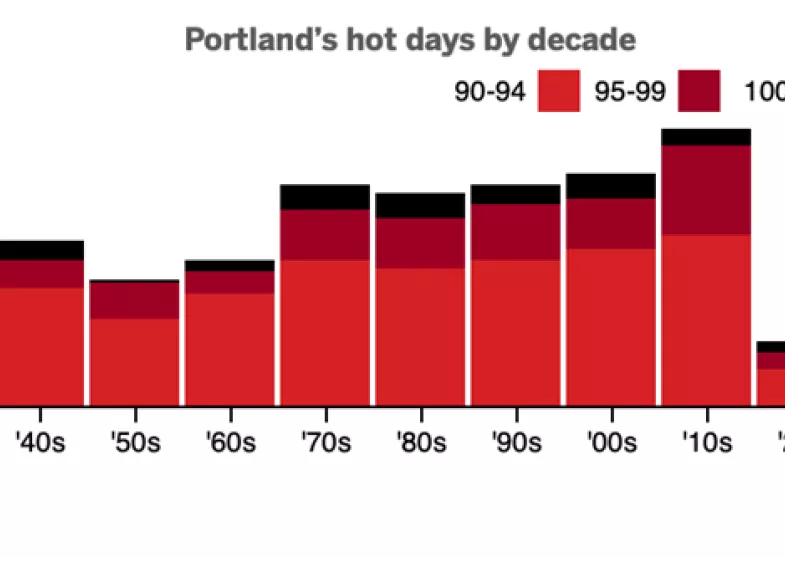
In the second installment of our Hot and Humid blog series, Phius Senior Scientist Graham Wright takes an in-depth look at heat stress and how passive measures can be used as a tool to combat overheating in hot and humid climates.
UPDATE: Oregon commemorates those lost during the 2021 Heat Dome and addresses heat concerns during Heat Week 2022.
We live in a warming world. Heat stress is going to be almost everyone’s problem, even if it isn’t already. Out here in Portland, Oregon, I’ve read that houses “traditionally don’t need air conditioning,” but already in 2009 when I first got here, it went up to 107° F, and last year in the “heat dome” event, 116° F. Below is a look at the amount of 90° or hotter days in Portland by decade.
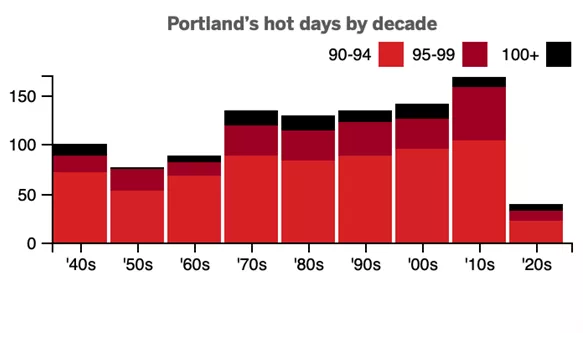
The most basic function of buildings is shelter – protection from the elements. When it comes to the cold, our beloved passive measures such as air-sealing and insulation can just about do this on their own, without any help from mechanical systems – at least to a survivable level and approaching a comfortable level. Passive building therefore offers good resilience for winter utility outages (as well as low heating bills in normal operation).
As Katrin mentioned in the first Hot and Humid Blog post on Feb. 18, we have been paying attention to design for heat and humidity in two contexts – both normal operation and outage resilience. Our current R&D for hot season/climate guidance is focused on the outage resilience angle.
I’ll argue here that:
- a) Heat is the greater threat than cold, especially hot and humid
- b) Though passive measures alone won’t suffice, they remain crucial
Biologically, it might seem that humans are more at risk from cold. In terms of core body temperature, hypothermia sets in at about 3° F below normal and hyperthermia at about 5° F above. We don't have much fur and appear to be built more for heat – horses and humans are almost the only creatures that can sweat profusely – an adaptation for running steadily in the heat.
But in practical terms of ambient temperature and humidity, the survival limit for heat is much closer to our preferred comfort condition than the survival limit for cold. Since ancient times, people managed to live year-round in places with freezing winters way below body temperature, using the heating technologies of clothing, fire, and commensal animals. Lately we have been thinking that the hard limit for winter survivability is exactly freezing, not because of human physiology but because of indoor plumbing.
But in the heat, it is about physiology. Consider a very lightly clad person sitting quietly in 100% relative humidity. A comfortable temperature would be 81° F according to the PMV model. But a temperature only 14° F higher at 100% RH, that is, a wet bulb temperature of 95° F, can kill even a healthy adult within hours. A wet bulb temperature of 95° F is believed to be the hard upper limit of human survivability. Luckily, this doesn’t currently happen in nature, though with 7° C more of global warming, it would, according to Sherwood & Huber (2010).¹
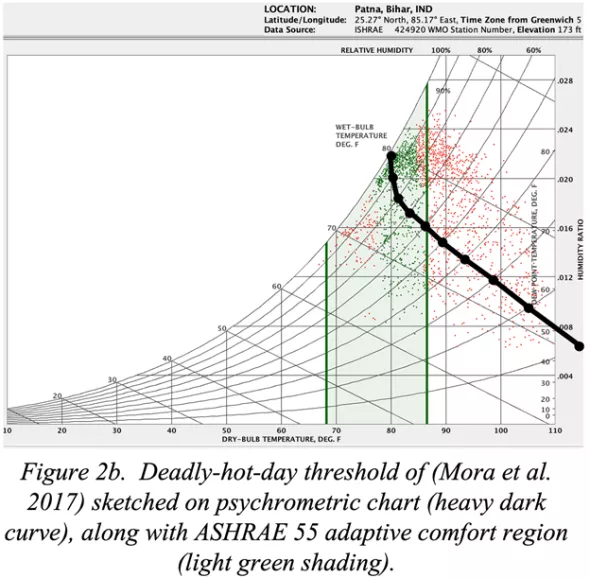
But of course, we are not healthy adults our whole lives; heat waves are known to kill already. An epidemiological limit was published by Mora et al (2017)². We plotted it on a psychrometric chart in Figure 2b of our BPACS 2020 paper³ (heavy black line). Note that it corresponds to a wet bulb temperature of 70-80° F depending on the relative humidity. It thus appears to be about equivalent to avoiding the Danger range of Heat Index, comparing to the chart from USGBC about their LEED pilot credit for resilience.⁴
One of the resources Mora et al developed is an interactive world map. This can show the predicted number of “deadly days” by their criterion, for present and future years under different warming scenarios (high, medium, and low emission). Returning to Portland, Oregon, note that even for the high emission scenario and in 2050, it predicts zero deadly days. But that June 28, 2021 day with the 116° F high had a day average of about 94° F (34° C) and 25% RH – this is already much closer to the line than the future forecast. These forecasts may be optimistic.
Heatwaves at Portland Oregon using RCP85 (business as usual), forecast for 2050.
But going into this, it’s becoming clear that in hot climates/seasons, it doesn’t make sense to regard passive measures as a clear priority anymore – high performance in hot climates is more of a partnership between passive measures, equipment efficiency, and solar PV. Passive measures can help hold onto the cooling that the active devices provide, but the active devices must provide it in the first place. Especially for latent cooling/dehumidification, there are almost no passive measures.
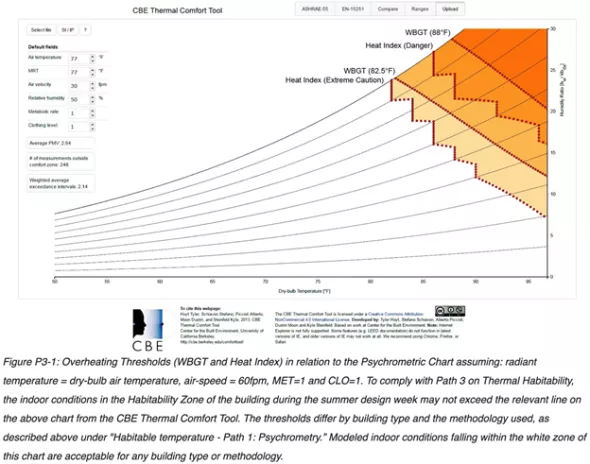
We are planning on using these Heat Index and Deadly Day criteria for upcoming outage resilience studies. This is being done in the context of the new Phius REVIVE Pilot program for retrofit. In a nutshell, the idea is to use resilience as the guiding principle for how much the building upgrades should contribute to decarbonization (as opposed to what the grid contributes):
- Upgrade the buildings to a point of outage resilience, for both summer and winter – everybody gets this.
- But phase in the retrofit – immediately electrify to the level of heating/cooling capacity that will be needed after the envelope upgrades are done.
- Do this at the best life-cycle cost, including cost of carbon, operating and embodied.
Again, as Katrin mentioned, we did consider cooling load in the process of setting the “normal operation” performance criteria for our current certification program.⁵ That used a cost-effectiveness objective and it was notable that the passive measures that were included to help with cooling – overhangs and thermal mass – almost always lost out to heat pump upgrades. Those passive measures evidently did not compete well with mechanical cooling in normal operation. Using an outage-resilience priority rather than cost-effectiveness may change the picture.
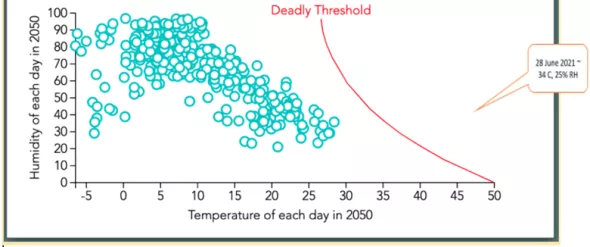
Our initial focus for heat wave resilience studies will be on the more generally applicable measures, passive and active: air-sealing, insulation, ERV, windows & blinds, heat pump, dehumidifier, PV, battery. It will include a couple of more nichey passive or hybrid measures that don't work everywhere: natural ventilation cooling or whole-house fan, basements, evaporative cooling. We want to find combinations of passive measures that can lower the load to the point where rooftop PV + mechanical can keep a place livable. We are aligning some of the study protocol, like the weather conditions, with the LEED Pilot credit.
Admittedly, a resilience strategy involving PV, batteries, and heat pumps is a relatively “high-tech” strategy and that may represent a vulnerability. We’re still interested in lower-tech or potentially more robust resilience measures for hot and humid climates such as moisture buffering materials, phase-change thermal mass, desiccant dehumidification, and even behavioral adaptations. One of the prepper tricks is “kiddie pool,” for example.
PS: I did a 2019 Phius conference presentation about passive design for heat wave survivability; some of that material was included in our 2020 peer-reviewed paper and is mentioned again in this post. I think the resources list on slide 18 is still pretty good.
______________________________________________________________________
¹ Sherwood SC, Huber M. 2010. An adaptability limit to climate change due to heat stress. PNAS [accessed 2022 Mar 16]; 107:9552–9555. https://www.pnas.org/doi/abs/10.1073/pnas.0913352107
² Mora C, Dousset B, Caldwell IR, Powell FE, Geronimo RC, Bielecki CR, Counsell CW, Dietrich BS, Johnston ET, Louis LV, et al. 2017. Global risk of deadly heat. Nature Climate Change [accessed 2020 May 15]; 7:501–506. https://maps.esri.com/
³ White L, Wright G. 2020. ASSESSING RESILIENCY AND PASSIVE SURVIVABILITY IN MULTIFAMILY BUILDINGS. 2020 Building Performance Analysis Conference, Chicago IL [accessed 2022 Mar 16]; https://www.techstreet.com/standards/assessing-resiliency-and-passive-survivability-in-multifamily-buildings?product_id=2095255 [free copies available from Phius]
⁴ USGBC. LEED v4 Pilot Credit IPpc100, REQUIREMENTS APPENDIX - Option 1: Provide for Passive Survivability (thermal safety). US Green Building Council; [accessed 2022 Mar 16]. https://www.usgbc.org/credits/new-construction-core-and-shell-schools-new-construction-retail-new-construction-data-48?view=resources
⁵ Wright G, White L. 2019. Setting the Heating/Cooling Performance Criteria for the PHIUS+2018 Passive Building Standard. Thermal Performance of the Exterior Envelopes of Whole Buildings XIV International Conference [accessed 2022 Mar 16]; 14:399–409. https://www.techstreet.com/standards/setting-the-heating-coolingperformance-criteria-for-the-phius-2018-passive-building-standard?product_id=2095337 [free copies available from Phius]
